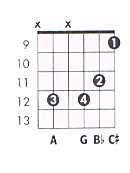


Melodies are the main series or sequences of notes in a piece of music, and harmonies are the notes which bring depth and support the melody.Įach of the columns in the image below are chords, and the notes in each chord should be played at the same time before moving on to the next chord. If you’re asking yourself what is a chord, keep reading for a brief explanation:Ĭhords are made up of at least two stacked notes which are played together at once to create a harmony. If you’re unfamiliar with chords in general, don’t worry! There are so many new symbols and words you need to know when you’re learning how to play the piano. These are just the fingering patterns: Feel free to use 5 when appropriate (first note, last note, turning around).Where B♭ Minor Chord Comes From What Exactly is a Chord, Anyway?.Because it is natural and easy to play arpeggios in threes, but not in fours, one’s focus should be on getting a convincing four-to-a-beat arpeggio sound (sixteenth-notes). Try to avoid accenting every three notes.Occasionally in the literature arpeggios have to be played with a smooth legato, but repeatedly passing the thumb such extreme distances can lead to injuries. When practicing arpeggios, don’t worry about maintaining a legato touch.In the literature, it may be appropriate to put the thumb on a black key for the sake of execution, but crossing to the thumb on a black key from a white key (or from the thumb on a black key to a white key) should be avoided whenever possible.The fingerings given below represent the “official” accepted uses of fourth and third fingers. Use whatever is most appropriate given the individual circumstances in the literature. The fourth and third finger are often interchangeable in the patterns.The fifth finger is only used at a starting place, a stopping place, or a turning-around place.

The thumb always stays on the white keys, except when there are no white keys (F♯/G♭ major and D♯/E♭ minor).The arpeggio fingering pattern repeats every three notes, so that every octave has the same fingering.

Piano Arpeggio Fingerings General Arpeggio Fingering Rules


 0 kommentar(er)
0 kommentar(er)
